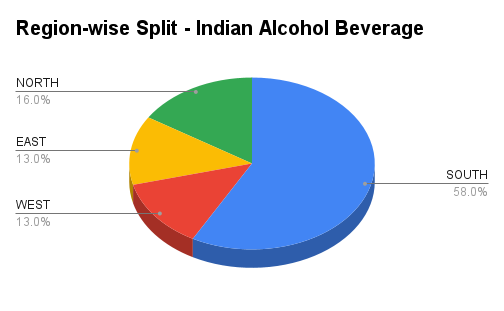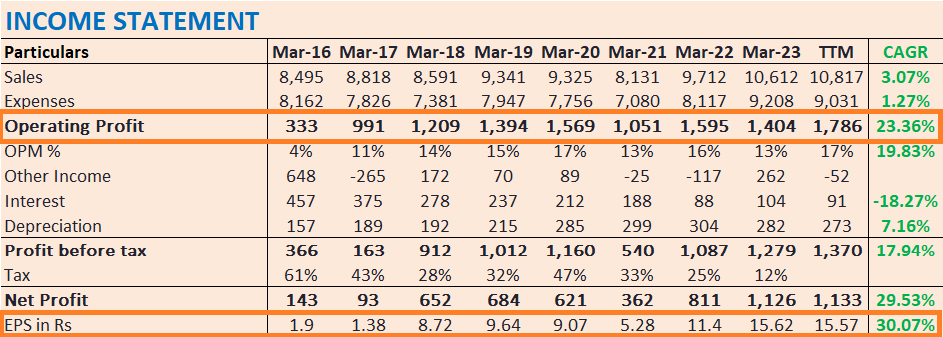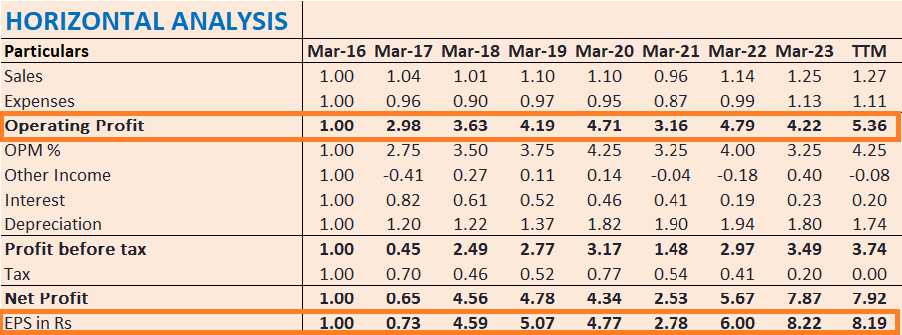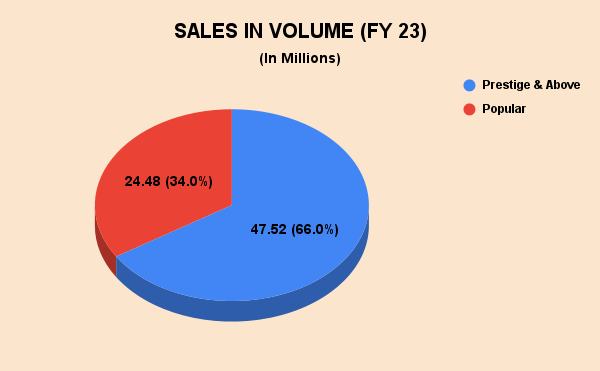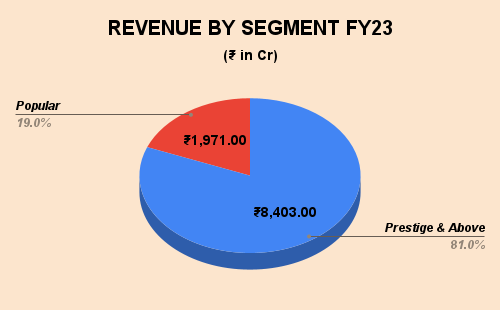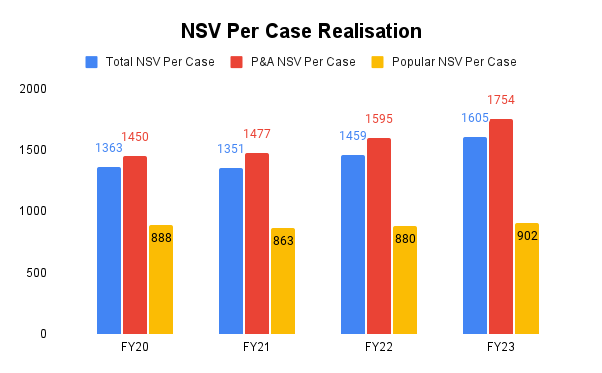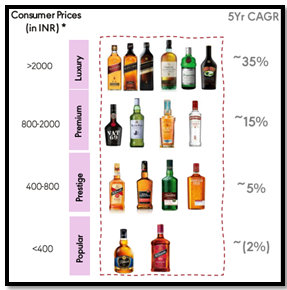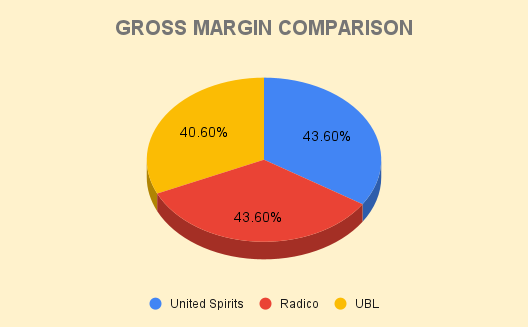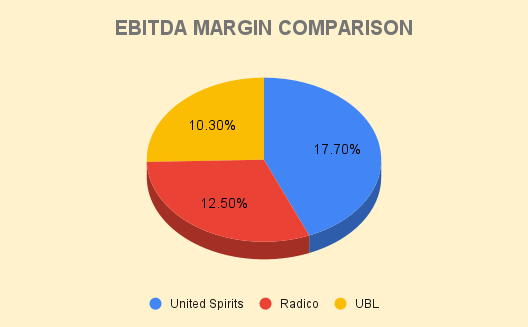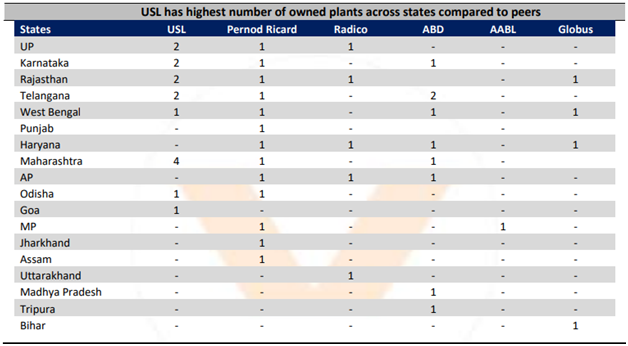United Spirits CMP – 1046.45
An Overview of United Spirits’ Financial Performance
United Spirits is a great example of how a company can make more money even when its sales grow slowly. United Spirits’ revenue has only increased by a CAGR of 3.07%. But, because United Spirits has become good at controlling its costs, its operating profit (money it makes from its core business) has grown much faster, at a CAGR of 23.36%. This has had a big impact on its earnings per share (EPS), which is a measure of how profitable the company is.
The EPS has grown at a rate of about 30.07%. This shows that when a company manages its costs well, it can still make a lot of money even if its sales aren’t multiplying.
Upon scrutinizing the Price/Earnings Growth (PEG) ratio of 5.12 and the Price/Earnings (P/E) ratio of 59.22 for United Spirits, our analysis reveals that the market currently attributes an anticipated growth rate of 11% to the company. However, we hold the perspective that, given improved margins and the imminent activation of operating leverage, United Spirits has the potential to achieve a growth rate of 15% in the next three years (For Calculations refer below).
Do you ever wonder how United Spirits was able to achieve such remarkable growth in the EPS?
What has been particularly enticing for Investors in United Spirits?
Diageo PLC holds 56% shareholding in United Spirits. After acquiring a majority stake in 2013, Diageo started restructuring the company by:
- Successfully reducing the company’s debt load from INR 5,165 Crores to nearly zero
- Selling off non-core assets
- Overall organization-level clean-up by getting a new leadership team
- Fixing the balance sheet by getting rid of non-core assets
- Controlling operations and supply chain by improving efficiencies and improving margin
- Deep focus on premiumization and improving share of premium segment to 81% of revenue through both double-digit volume as well as value growth rate hence bringing profitability back on track
- Improving route to customer strategy across states considering regulatory constraint
DEBT TO EQUITY RATIO
United Spirits Limited – Company Overview
United Spirits Limited (UNSP) is one of the country’s leading beverage alcohol companies and a subsidiary of global leader Diageo PLC.
United Spirits manufactures, sells, and distributes an outstanding collection of premium brands such as Johnnie Walker, Black Dog, Black & White, Vat 69, Antiquity, Signature, Royal Challenge, McDowell’s No1, Smirnoff, and Captain Morgan.
PRODUCT PORTFOLIO
United Spirits has brands spanning across price points operating in all segments of Popular, Prestige, Premium, and Luxury.
United Spirits has a comprehensive brand portfolio with over 63 brands of Scotch whisky, IMFL whisky, brandy, rum, vodka, and gin.
McDowell’s No.1, Royal Challenge, Royal Challenge American Pride, Signature, Antiquity, Black Dog, Director’s Special Black, McDowell’s Rum & McDowell’s Brandy are some of the marquee brands owned by United Spirits.
United Spirits also imports, manufactures, distributes, and sells various iconic Diageo brands such as Haig Gold Label, Captain Morgan, Johnnie Walker, J&B, Baileys, Lagavulin, Talisker, VAT 69, Black & White, Smirnoff and Ciroc in India under different licensing agreements.
Did you know that whiskey dominates the IMFL category?
India takes the lead with the largest whiskey industry in the world – The Indian market has a growth rate of 7% up even more in premium plus segments such as whisky.
- India-based United Spirits Limited’s McDowell’s No. 1 is the most prominent whiskey. Its Royal Challenge and Bagpiper are also popular.
- Other prevalent whiskies include French Pernod Ricard’s Imperial Blue, Seagram’s Blender’s Pride, Royal Stag, and Japanese Beam Global’s Teachers.
- UNSP is the market leader with more than 45% market share in whisky, which comprises 73% value of total liquor sold in India.
United Spirits produces and sells around 72 million cases annually.
- The prestige and above segment commands a significant share, constituting 66% of the total volumes and contributing 47.52 million units.
- Popular segment holds a 34% representation, contributing 24. 48 million units to the overall volume.
9 brands with sales >1 mn cases – USL has 9 brands in its portfolio that sell more than a million cases every year, of which 1 brand sells more than 25 million cases annually.
Pernod Ricard holds a fourth of the whisky segment with Indian brands like Royal Stag, Imperial Blue, and Blenders Pride. Their Scotch brand 100 Pipers is India’s highest-selling with over 1.5 million cases sold annually.
United Spirits recorded a revenue of ₹10,374 Cr in FY23.(On Standalone basis)
- Prestige & Above segment represented 81% of total net sales contributing ₹8403 Cr to total revenue up from 45-50% five years ago, indicating a strong focus on premium segments.
- Popular segment represented 34% of total net sales contributing ₹1971 Cr to total revenue
United Spirits is focusing on expanding mass volume in the Premium and Above segment to leverage favorable margins. The company has witnessed an impressive increase in Net Sales Value in P&A Segment (NSV) from Rs. 1450 in FY20 to Rs. 1754 per unit in FY23 growing at a CAGR OF 5.63%, attributed to a strategic product mix aligned with higher-tier market segments.
Also if we look at Revenue contribution from the P&A segment now contributes to 81% of total sales up from 45-50% five years ago
So if we look at Revenue calculation
Revenue = Price * Quantity
United Spirits has been mainly working on increasing the Total NSV(Net Sales Value) from Rs. 1363 in FY20 to Rs. 1605 in FY23, which has boosted their total sales value. But if they can also sell more quantity, with some favorable conditions helping them out, they could significantly grow their overall revenue.
UNITED SPIRITS PROJECTED REVENUE FOR FY 2024 (Full Year) – Standalone basis
For H1FY24
Premium & Above – 1805 * 24.34 mn = 4397 Cr
Popular – 993 * 5.023 = 499 Cr
Premium & Above – On a three-year basis, United Spirits posted revenue growth of 54.55 percent in H1FY24 (versus H1FY21)
United Spirits has had a robust performance with a commendable revenue of Rs. 5037 Crores in H1 FY2024. The company is well-positioned to command a premium in the popular and above segments. Our analysis suggests that with a 5% increase in Net Sales Value (NSV) and a 20% growth in volume, United Spirits is poised for continued success in the upcoming festive season. This strategic approach aligns with market dynamics and sets the stage for sustained positive momentum in the company’s performance.
BASE CASE SCENARIO for H2 FY 2024
Premium & Above – 1895 * 29.208 = Rs. 5534.9 Crore
Popular – 1042 * 5.123 = Rs. 533 Crore
Full Year Revenue
4896 + 6068 = Rs. 10964 Crore
So we are seeing an incremental growth of 5.78% YOY growth
PEER COMPARISON
- Gross margin– United Spirits and Radico topped at 43.6 percent, and UBL at the bottom at 40.6 percent
- EBITDA margin- United Spirits outpaced Radico and UBL. United Spirits clocked an EBITDA margin of 17.7 percent aided by a sharp bump-up in IPL and product mix improvement, followed by Radico at 12.5 percent while UBL had a mere 10.3 percent EBITDA margin- Analysing the EBITDA margin on a four-year basis, United Spirits did well with its EBITDA margin staying flat. On the other hand, Radico witnessed an EBITDA margin contraction of 359 bps while UBL is at the bottom with its gross margin nosediving 580 bps.
- Revenue Growth– On a four-year basis, Radico posted robust revenue growth of 53 percent in Q1FY24 (versus Q1FY20) followed by UBL at 11 percent. United Spirits, on the other hand, posted an overall revenue decline of 2.1 percent due to slump sale of the business undertaking associated with 32 brands and the franchising of 11 Popular brands to an unrelated party
- Volume Growth-Premiumisation marks the most important theme for these companies, transiting to a more value-led growth in the P&A segment. For instance, on a four-year basis, Radico posted robust revenue and volume growth in the P&A segment of 65.5 percent and 22.6 percent (versus Q1FY20), respectively, followed by UNSP at 31.8 percent and 12.1 percent P&A revenue and volume growth, respectively
-
Multi-locational manufacturing facilities to aid in scaling up volumes- USL has 15 manufacturing locations and 50+ manufacturing units which is among the highest manufacturing footprint among spirits companies in India. Given that high intra-state taxation restricts the movement of alcoholic beverages across states, the availability of pan-India manufacturing bases helps to increase the scale
Region-wise Split – Indian Alcohol Beverage Industry (in Volumes)
The Southern region has remained the largest contributor to sales volume with a 58 percent share followed by the West and East, which contributed 26 percent equally. The North region contributed 16 percent of the total sales
The states of Karnataka, Maharashtra, West Bengal, Odisha, Telangana, Delhi, Haryana, Punjab, etc. are amongst the largest consuming states for Alcobev in India
KEY RISK AND CHALLENGES FOR UNITED SPIRITS
Raw Material Cost: Extra neutral alcohol (ENA) and Glass are key raw materials for United Spirits. ENA is derived from Sugar and other sources, the prices of ENA which makes roughly 40% of the RM costs prices had shot up in H1FY20, leading to margin pressures on the industry.
Now USL’s share of grain-based raw material-based spirits has been going up as a % of its Raw materials from 10% in 2008 to 70% in 2019.
Also, management is doing tactical things in terms of increasing their physical coverage and going slightly long on physical storage contracts. And, the longer-term intervention of increasing their co-location footprint as a part of the supply agility program
The Risk of More States Going Dry – States like Gujarat and Bihar are completely dry with no alcohol sales permitted in these states. More states could go dry as a populist measure which could hurt profitability and consequently the share price of United Spirits share.
Major Headwinds called out by Management: The ethanol fuel blending policy, union elections, the increase in minimum support prices on the feedstocks, and the El-Nino factor- El Nino, the warming of waters in the Pacific Ocean near South America, is generally associated with weakening monsoon winds and dry weather in India
Pricing challenges: Pricing continues to remain a challenge for the category since with the continuous increase in excise duties, end consumer prices continue to experience an upsurge with no benefit to the company.
Government Policies: Increased tendency towards prohibition in an election year. Another concern emerges from the dependence on state governments to get price increases. Margins may get severely impacted in case of inflation in raw material costs or any increase in cost due to changes, in regulations.
Distribution Concerns: Every state has its own set of regulations governing alcohol manufacture and distribution, retailing, pricing, levies, and duties,
In states where retailing is controlled by the state government, there is a specified quota that each player can sell, capping the potential to increase market share for our products. These regulations make operations restrictive for the industry players
PORTERS FIVE FACTORS
Threat of New Entry (Low to Medium): The Indian alcohol market is a media-dark industry, where advertising is restricted. Stringent state-wise regulations and restrictions on advertising could create challenges for new players to enter this market, and create a loyal customer base for their products
Bargaining power of buyers (Medium to High): The growth in Excise duty and revenues shows the companies are not Inelastic to demand where the price increase doesn’t dampen its demand. In India, most of the states are controlling the prices of alcohol because the Excise duty is paid to the state govt and GST to the central government, which makes it difficult to increase prices when excise or raw material costs have increased
Threat of Substitution (Medium to High): Social media exposure through the pandemic has shortened the time for global trends to catch on in India. There has been a change in dining-out habits, especially about cocktails. More people are looking for newer experiences in the form of signature cocktails, and are willing to pay more for premium beverages.
Supplier Power (High): In numerous instances, government entities play a central role in determining market routes and granting liquor sale licenses, leading to significant government intervention in the supply chain process.
Competition in the industry (High): The Indian alcoholic beverage market is experiencing intensifying rivalry spurred by the launch of several new spirits. Companies such as Radico Khaitan, Allied Blenders & Distillers Ltd, and Khemani Distilleries Pvt. Ltd has introduced multiple spirits across categories such as whisky, gin, and rum. The main impetus behind this surge of innovation is a mix of stiff competition and growing consumer acceptance of Indian brands.


